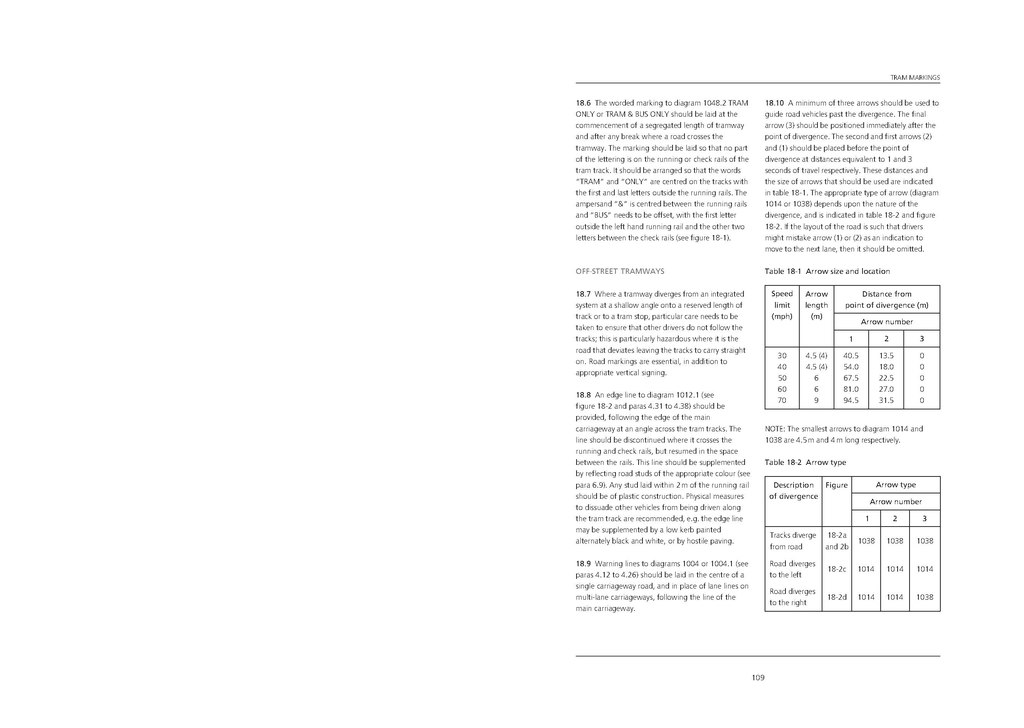18.6 The worded marking to diagram 1048.2 TRAM ONLY or TRAM & BUS ONLY should be laid at the commencement of a segregated length of tramway and after any break where a road crosses the tramway. The marking should be laid so that no part of the lettering is on the running or check rails of the tram track. It should be arranged so that the words "TRAM"” and "ONLY" are centred on the tracks with the first and last letters outside the running rails. The ampersand "&" is centred between the running rails and "BUS" needs to be offset, with the first letter outside the left hand running rail and the other two letters between the check rails (see figure 18-1).
OFF-STREET TRAMWAYS
18.7 Where a tramway diverges from an integrated system at a shallow angle onto a reserved length of track or to a tram stop, particular care needs to be taken to ensure that other drivers do not follow the tracks; this is particularly hazardous where it is the road that deviates leaving the tracks to carry straight on. Road markings are essential, in addition to appropriate vertical signing.
18.8 An edge line to diagram 1012.1 (see figure 18-2 and paras 4.31 to 4.38) should be provided, following the edge of the main carriageway at an angle across the tram tracks. The line should be discontinued where it crosses the running and check rails, but resumed in the space between the rails. This line should be supplemented by reflecting road studs of the appropriate colour (see para 6.9). Any stud laid within 2m of the running rail should be of plastic construction. Physical measures to dissuade other vehicles from being driven along the tram track are recommended, e.g. the edge line may be supplemented by a low kerb painted alternately black and white, or by hostile paving.
18.9 Warning lines to diagrams 1004 or 1004.1 (see paras 4.12 to 4.26) should be laid in the centre of a single carriageway road, and in place of lane lines on multi-lane carriageways, following the line of the main carriageway.
| Speed limit (mph) |
Arrow length (m) |
Distance from point of divergence (m) | ||
|---|---|---|---|---|
| Arrow number | ||||
| 1 | 2 | 3 | ||
| 30 | 4.5 (4) | 40.5 | 13.5 | 0 |
| 40 | 4.5 (4) | 54.0 | 18.0 | 0 |
| 50 | 6 | 67.5 | 22.5 | 0 |
| 60 | 6 | 81.0 | 27.0 | 0 |
| 70 | 9 | 94.5 | 31.5 | 0 |
NOTE: The smallest arrows to diagram 1014 and 1038 are 4.5 m and 4 m long respectively.
| Description of divergence | Figure | Arrow Type. | ||
|---|---|---|---|---|
| Arrow Number. | ||||
| 1 | 2 | 3 | ||
| Tracks diverge from road | 18-2a and 2b |
1038 | 1038 | 1038 |
| Road diverges to the left | 18-2c | 1014 | 1014 | 1014 |
| Road diverges to the right | 18-2d | 1014 | 1014 | 1038 |
109
